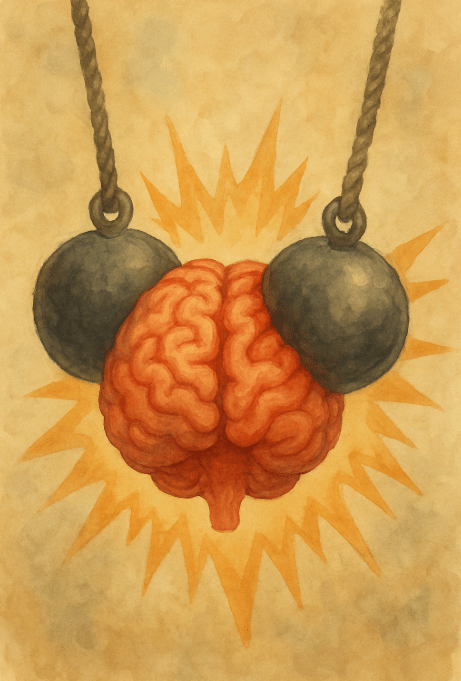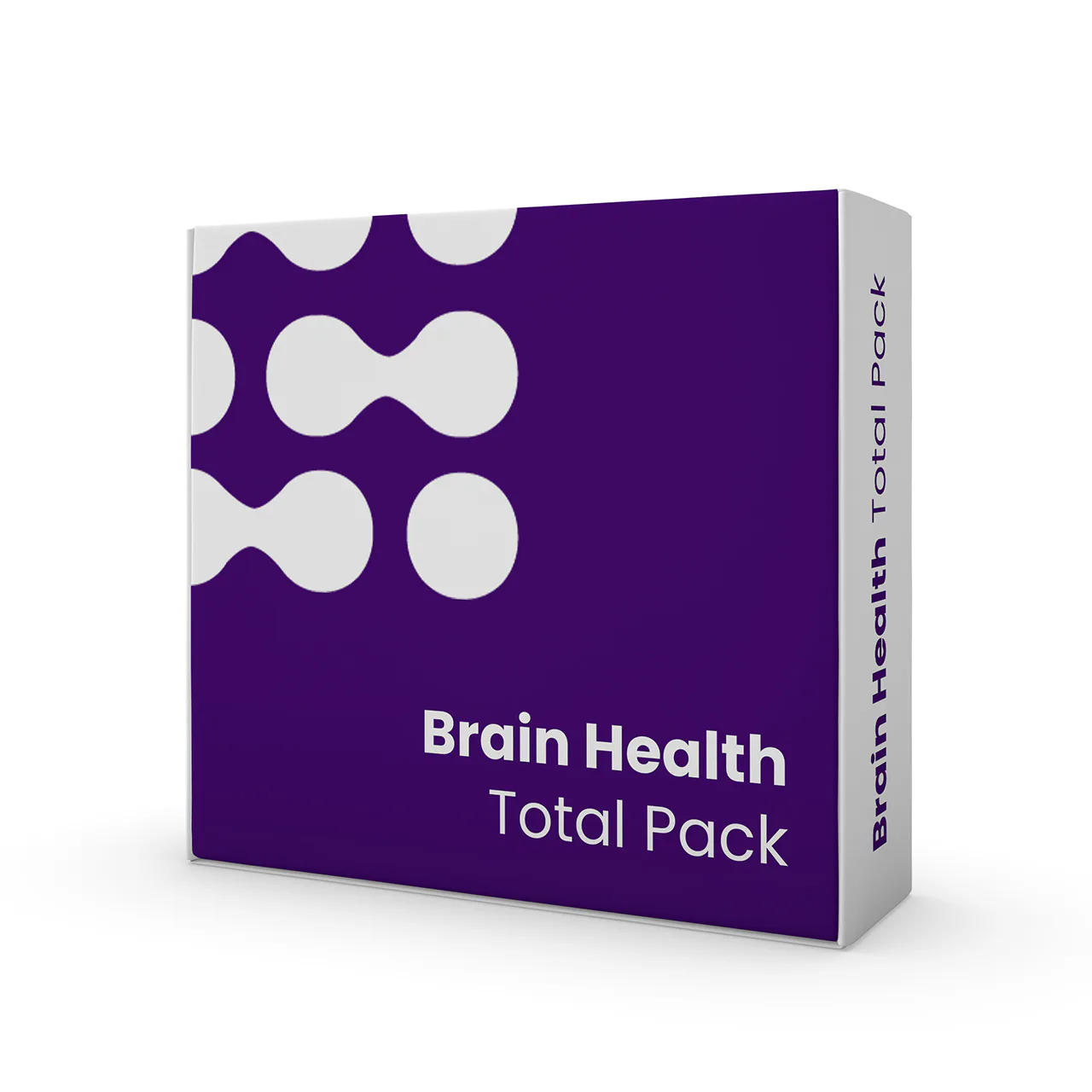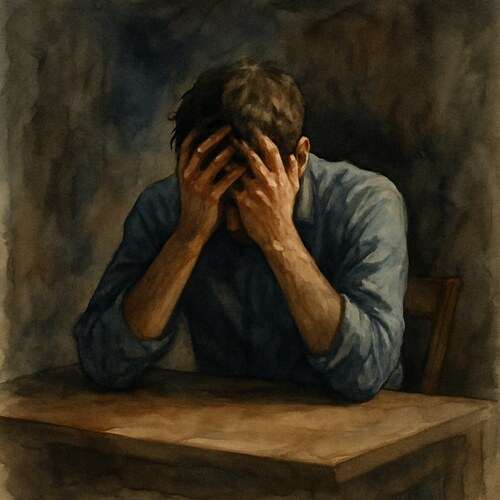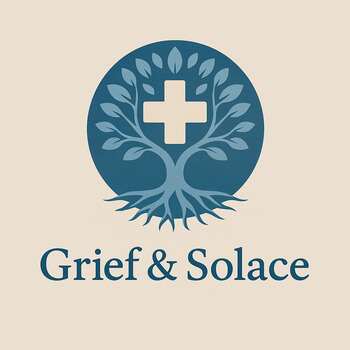Grieving Brain Injury: Mourning the Mind While the Body Survives
Grief after brain injury is its own kind of death the slow, aching realization that the person you loved survived, but not the way you remember.

This post blends real grief with grounded knowledge. It isn’t clinical. It isn’t distant. It’s meant to sit beside you—not above you. The story you’ll read is meant to reflect what so many feel when living through or witnessing this condition: confusion, exhaustion, and quiet forms of courage.
If what you read feels familiar, please speak with your doctor. Your pain deserves more than silence.
His Heartbeat Stayed, but His Smile Did Not
We kept counting his heartbeat like that would bring the rest of him back
The doctors assured us he was stable…stable…but that word felt hollow when his eyes opened and didn’t recognize the room.
It wasn’t a dramatic, cinematic moment, He knew his name… could name the year, and effortlessly recited the birthdays of everyone present. But his smile felt off. The laughter hung awkwardly in the air, and the pauses before each of his answers were long enough to remind us: that something had changed.
It wasn’t due to a car crash or a fall. It was a quieter kind of injury…a silent insult from within, a sudden bleed, a moment when the brain stopped receiving what it needed. It was as if someone had unplugged the cord just long enough for everything to go haywire. We thought we’d lost him, but thankfully he lived. Now, we faced the challenge of learning how to lose him while he was still here.
🧠 Symptoms:
- Mild TBI:
Headache, fatigue, nausea, dizziness, or speech issues - Sensory changes (blurred vision, ringing ears, taste/smell alterations)
- Memory issues, confusion, sleep disturbances
- Mood swings, anxiety, depression
- Moderate to Severe TBI:
Loss of consciousness (minutes to hours) - Persistent headache, seizures, pupil dilation
- Weakness or numbness in limbs, coordination loss
- Slurred speech, agitation, profound confusion
- Coma or vegetative states
- In Children:
Irritability, change in eating/sleep habits - Persistent crying or loss of interest in favorite activities
- Seizures or drowsiness
At first, it was the small things: His quick temper had vanished entirely. He smiled at funerals and laughed at jokes that fell flat. He called me by name but couldn’t recall the street we grew up on. He remembered our childhood games but forgot how to finish them; and, oh, how he struggled to read a room.
That’s what they don’t tell you: Brain injury doesn’t come with a cast or a brace, or a visible scar to explain the shift. It arrives in a thousand subtle rewrites. It brings with it the ache of recognition, the person before you has your brother’s eyes, your son’s voice, your husband’s laughter, yet something vital is missing…
We kept hoping he would return to us. Rehab helped to an extent. They provided us with tools, handbooks, breathing techniques, and schedules, but nothing could prepare us for the moment he forgot my birthday yet somehow vividly recalled a random jellybean flavor from a road trip back in 2002. Or the day he told my daughter the same story four times, each retelling met with the same delighted smile as if it were brand new.
The reality is, is that he’s trying…he truly is. He gets frustrated, sometimes crying without even knowing the reason. Other times, he zones out mid-sentence, as if the road beneath him has simply vanished.
Complications:
- Consciousness Disorders:
Coma: No awareness, may progress or resolve - Vegetative state: Reflexes intact, no conscious awareness
- Minimally conscious: Some awareness returns
- Brain death: Irreversible loss of brain function
- Physical & Neurological:
Seizures (acute or post-traumatic epilepsy) - Hydrocephalus (fluid buildup)
- Skull fractures, infections, blood vessel damage
- Headaches, vertigo, cranial nerve damage (e.g., vision, hearing, facial paralysis)
And I find myself loving both versions of him. Even the version that forgets to wear socks. Even the version that says, “I’m fine,” yet stares too long at walls.
His heartbeat remains steady, and his body is intact. But the smile—the one that used to resonate perfectly before the punchline? That part still hasn’t found its way home. And maybe, just maybe, it never will.
Risk Factors:
- Children under 4
- Young adults (15–24)
- Adults over 60
- Males in all age groups
Causes:
- Falls (especially in children and older adults)
- Vehicle-related collisions
- Physical violence (including shaken baby syndrome)
- Sports injuries (especially youth sports)
- Military blast injuries
- Penetrating trauma or object collision
And me? I smile, I nod, and I keep anchoring the moment over and over, as though I’m holding the earth to its axis every time he slips away.
Now, we celebrate milestones that used to feel automatic, he remembered my coffee order, asked about my day, and managed to sit through an entire movie without needing me to explain the plot.
But progress isn’t a straight line. It’s a loop…one step forward, two forgotten birthdays, a meltdown in the grocery store, and then a quiet apology that pierces your heart with its earnestness. Because he knows… Deep down, he recognizes he’s not who he once was, yet he struggles to comprehend how to stop grieving that loss.
Complications:
- Cognitive:
Memory loss, slow processing, impaired concentration - Judgment and problem-solving issues
- Executive dysfunction (organization, planning, task completion)
- Communication:
Trouble speaking, writing, or understanding language - Difficulty interpreting nonverbal cues or emotional tone
- Dysarthria (slurred speech due to muscle weakness)
- Behavioral:
Impulsivity, poor judgment, risky behavior - Lack of awareness, emotional detachment
- Outbursts, social inappropriateness
- Emotional:
Depression, anxiety, irritability, mood swings - Insomnia, reduced empathy, increased aggression
- Sensory:
Hearing loss, ringing ears, blurred or double vision - Loss of smell/taste, tingling or pain, imbalance
- Degenerative Risk:
Possible links to Alzheimer’s, Parkinson’s, or dementia pugilistica with repeated or severe injuries
Not all comas end when the eyes open. Some take years to wake the rest of the soul.
📘 Diagnosis & Treatment
Diagnosis:
Glasgow Coma Scale: Rates initial responsiveness (3–15)
History: Witness input about injury mechanics and symptoms
CT Scan: Fast imaging for bleeding, fractures, and swelling
MRI: Detailed soft tissue imaging for stable patients
Intracranial pressure monitor: Assesses swelling effects on brain function
Treatment:
Mild TBI:
Rest and monitoring: Avoid overstimulation; gradual return to activity
- Pain management: OTC medications unless advised otherwise
- Follow-up care: For symptom persistence or worsening
- Emergency Response (Moderate/Severe):
Stabilization: Oxygen, blood flow, neck/head protection - ICU management: Minimizes secondary damage from bleeding, swelling, or hypoxia
Medications:
Anti-seizure drugs: Prevent early post-trauma seizures
- Coma-inducing medications: Reduce brain’s oxygen needs
- Diuretics: Relieve brain swelling
Surgery:
Hematoma removal
- Skull repair
- Stopping internal bleeding
- Pressure relief (e.g., craniotomy)
Rehabilitation:
- Starts in the hospital, continues across inpatient or outpatient settings. Team may include:
- Physiatrist: Oversees recovery and medications
- Physical therapist: Rebuilds balance, strength, coordination
- Occupational therapist: Re-teaches daily tasks
- Speech-language therapist: Aids communication or swallowing
- Neuropsychologist: Assists with memory, behavior, mental wellness
- Social worker/case manager: Navigates services and care plans
- Recreational therapist: Rebuilds engagement with hobbies and daily structure
- Vocational counselor: Aids job re-entry or career adaptation
Coping & Daily Life:
- Support groups: Normalize struggles, offer shared wisdom
- Routine creation: Reduces stress and confusion
- Notes & reminders: External memory systems
- Task modification: Simpler steps, longer time, fewer distractions
- Environment control: Limit noise, chaos, and overstimulation
- Workplace/school flexibility: Allow breaks, alternate formats, adjusted workload
I know this is heavy, and I understand that the road ahead may feel like a tangle of loss and unanswered questions. But please hear this: you are not broken because you are hurting; you are not weak because you are afraid. You are living through something real, and survival itself is a kind of grace. You are allowed to struggle, you are allowed to hope, and you are allowed to not have all the answers today. Whatever comes next, you do not face it empty-handed; you carry every moment of love that shaped you, and that will always be enough to keep going.
🎀 Gifts to help With Brain Injury
🏥 Everyday Comforts for Everyday Battles
Managing Brain Injury often means needing a little extra help.
Sometimes it’s about restoring dignity, ease, or simply getting through the day with less pain.
These carefully chosen tools aren’t just items; they’re small bridges back to living.
This section is about finding practical support never shame.

Adaptive Voice-to-Text Tablet – For When Words Won’t Leave the Brain the Right Way
Non-traumatic brain injuries can fracture language, memory, and motor control—leaving the person inside fully aware but struggling to express themselves. This adaptive tablet offers voice-to-text functionality, large-print display, and customizable settings to match various communication impairments. It isn’t just a tool. It’s a bridge—restoring some control when the mouth and mind stop syncing.
🌿 Paths to Healing Beyond the Map
Sometimes traditional medicine isn’t enough.
If you’re exploring gentle, alternative options to help with Brain Injury,
you might find comfort in plant-based compounds like **CBD or CBG**.
*This section is not medical advice, just a door left open.*
USA Medical Brain Health Total Pack – Gentle Support After Neurological Injury
After a stroke, seizure, or oxygen deprivation, healing doesn’t just mean survival, it means rebuilding connections. The Brain Health Total Pack blends nootropics, vitamins, and broad-spectrum CBD to gently support focus, mental clarity, and nerve health. It’s not a fix. But for those navigating brain fog, memory gaps, or recovery fatigue, it offers a little light through the static.
Need a Different Path Forward?
Every journey through grief looks different. Choose the next step that speaks to where you are now:
When You're Ready to Start Healing
Healing doesn’t mean forgetting.
It means finding small ways to carry your grief with strength and grace.
These are the stories, tools, and gentle steps to begin walking forward…at your own pace.
When You're Still in the Thick of It
Sometimes healing feels like a lie.
If you’re not ready to move on…if the pain still roars louder than the world wants to hear…this is the place where you’re allowed to feel it.
No sugarcoating. No pretending. Just truth.
When You're Holding on to Who’s Still Here
Grief reminds us to love louder.
If someone you love is still with you, this is your place to celebrate them, honor them, and create new memories while there’s still time.
Joy and sorrow can live side by side.





